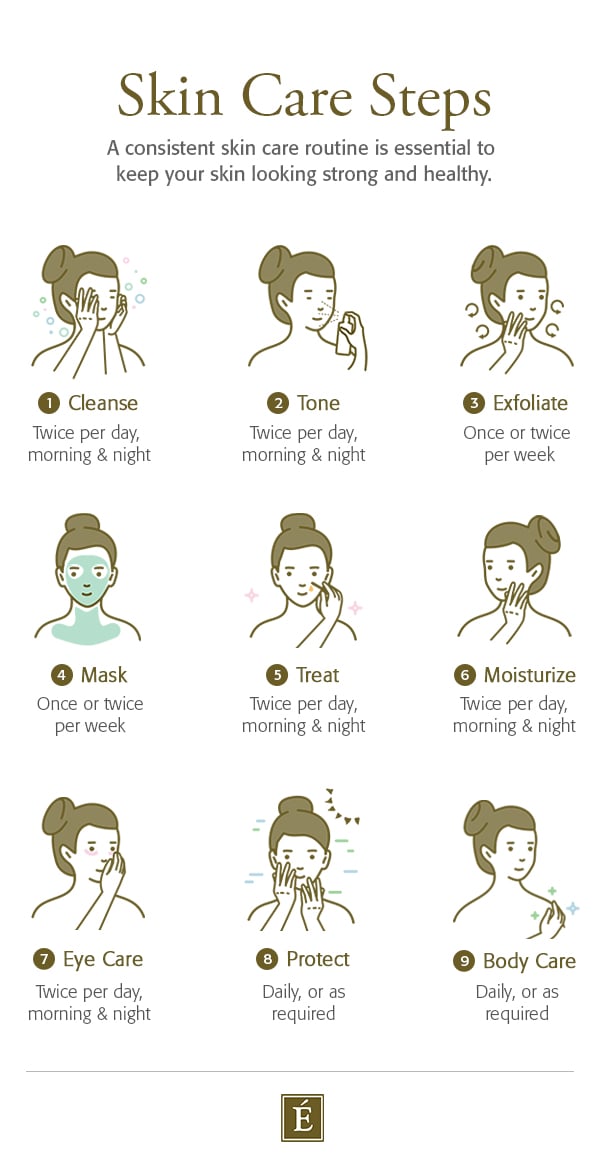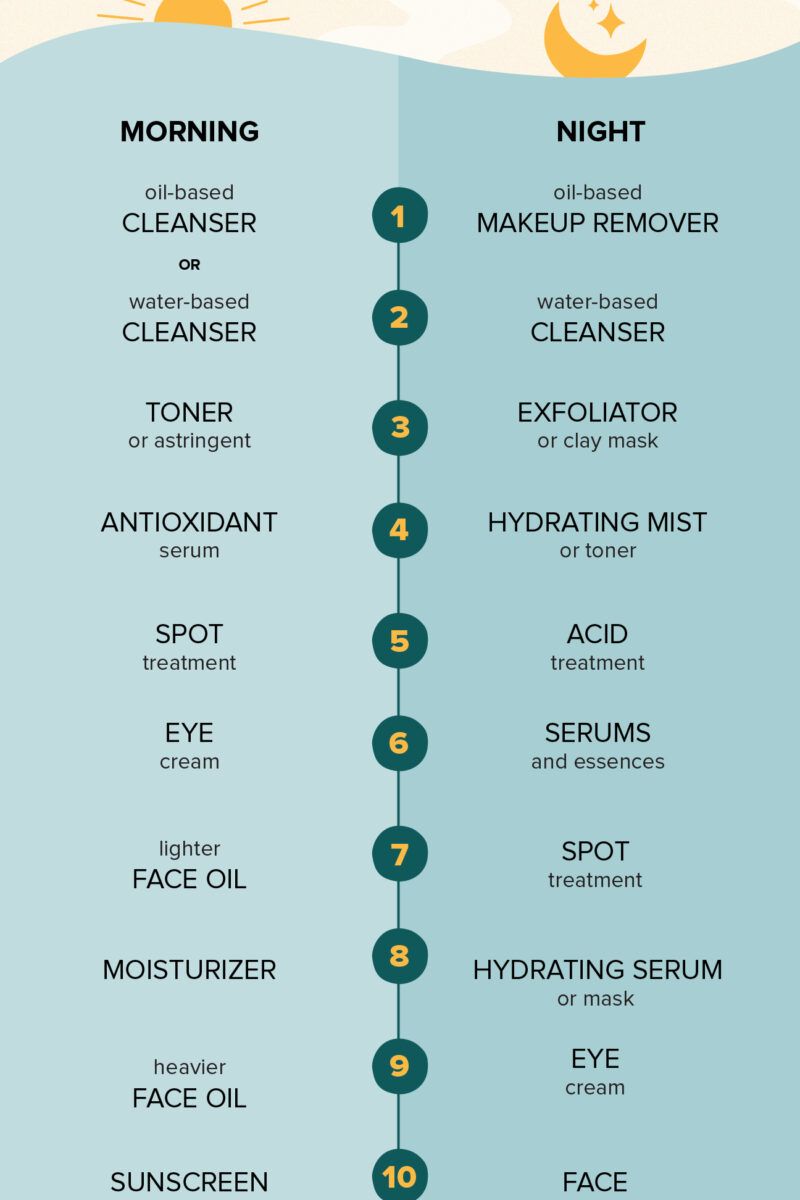Step by Step Skin Care Routine: Unveil Radiant Skin!
A step-by-step skincare routine includes cleansing, toning, treating, moisturizing, and protecting the skin. Follow this sequence daily for optimal skin health.
A well-structured skincare routine can transform your skin and boost your confidence. Proper care helps address various skin concerns, such as dryness, acne, or aging. Each step in your routine serves a unique purpose, ensuring your skin remains healthy and radiant.
Cleansing removes impurities, while toning balances pH levels. Treatments target specific issues, and moisturizing locks in hydration. Finally, sunscreen protects against harmful UV rays. Establishing this routine can lead to significant improvements in your skin’s appearance over time. Understanding the importance of each step enables you to tailor your routine to your specific needs, promoting a glowing complexion and overall skin wellness.
Introduction To Skin Care Essentials
Daily skin care is very important for everyone. It helps keep your skin healthy and glowing. A good routine can prevent many skin problems. Simple steps make a big difference.
Key components of a healthy skin regimen include:
- Cleansing: Removes dirt and oil from your skin.
- Toning: Balances skin’s pH and tightens pores.
- Moisturizing: Keeps skin hydrated and soft.
- Sun Protection: Shields skin from harmful UV rays.
Using the right products is essential. Choose items that suit your skin type. This ensures better results and healthier skin.

Credit: www.dermstore.com
Determining Your Skin Type
Identifying your skin type is important for effective skin care. There are four common skin types: normal, oily, dry, and combination.
Normal skin feels balanced. It is not too oily or dry. Pores appear small and barely visible.
Oily skin has excess oil. It often appears shiny. Pores are larger and may have blackheads.
Dry skin feels rough or flaky. It can feel tight and may show redness. Fine lines may appear.
Combination skin shows traits of both oily and dry skin. The T-zone may be oily, while other areas feel dry.
To identify your skin type, wash your face and wait for an hour. Observe how your skin feels. This simple test helps you choose the right products.
Morning Rituals For A Fresh Start
Cleansing your face starts the day right. Use a gentle cleanser to remove dirt. This helps your skin feel fresh and clean.
Toning is important for preparing your skin. A good toner balances your skin’s pH. It also helps to tighten pores and remove leftover cleanser.
Moisturizing keeps your skin hydrated. Choose a lightweight moisturizer for daytime use. Don’t forget to apply SPF protection to shield your skin from harmful UV rays.
These steps create a strong base for your skin. They help you look and feel great all day!
Evening Routine To Repair And Rejuvenate
Night-time cleansing is crucial for healthy skin. It removes dirt and makeup. Choose a gentle cleanser for your evening routine. This helps prevent clogged pores and breakouts.
Applying serums and treatments enhances skin repair. Use a serum with antioxidants. These ingredients fight free radicals and boost skin health. Apply treatments targeted at specific issues.
Hydration during the night is key. Use a rich moisturizer to lock in moisture. Consider using a sleep mask for extra hydration. This helps your skin feel fresh and revitalized by morning.
Weekly Skin Care Enhancements
Exfoliation is key for revealing brighter skin. It removes dead skin cells. This process helps to unclog pores and promote new cell growth. Aim for exfoliating 1-2 times a week for best results.
Masking offers deep cleaning and nourishment. Use a mask that suits your skin type. Clay masks help absorb excess oil. Hydrating masks provide moisture, making skin feel soft and smooth. Apply masks once a week for optimal effects.
Facial steaming opens up pores and allows for better product absorption. It increases blood circulation, promoting a healthy glow. Steam for 5-10 minutes, then follow with a moisturizer. This simple step enhances your overall skin care routine.

Credit: info.eminenceorganics.com
Targeting Specific Skin Concerns
Acne and blemishes can be controlled with proper techniques. Use a gentle cleanser daily. Incorporate salicylic acid or benzoyl peroxide products. Regular exfoliation helps remove dead skin cells. Always moisturize to keep skin hydrated.
Anti-aging treatments are crucial for youthful skin. Use products with retinol or hyaluronic acid. Daily sunscreen protects against harmful UV rays. Stay hydrated to maintain skin elasticity. Regularly apply nourishing serums for best results.
For sensitive skin, choose fragrance-free and hypoallergenic products. Avoid harsh chemicals that can cause irritation. Patch test new products before applying. Keep skin moisturized with gentle creams. Limit exposure to extreme temperatures.
Lifestyle Factors Impacting Skin Health
Diet and hydration play vital roles in skin health. Eating fruits and vegetables provides essential vitamins. Drinking enough water keeps skin hydrated and glowing. Aim for at least eight glasses daily.
Sleep affects how skin looks. Lack of sleep can cause dark circles and dullness. A good night’s sleep helps skin repair and renew.
Exercise boosts blood circulation. Better circulation means more nutrients for the skin. Regular workouts also help reduce stress, which can harm skin health.
Navigating Through Skin Care Products
Choosing the right ingredients is crucial for effective skin care. Look for natural and active ingredients that suit your skin type. Common ingredients include hyaluronic acid, salicylic acid, and vitamin C. Always check the concentration of these ingredients for better results.
Understanding product labels helps in making informed choices. Look for terms like non-comedogenic, which means it won’t clog pores. Claims such as dermatologist-tested can also indicate product safety. Avoid products with too many chemicals or fragrances.
Building a customized skin care kit is essential. Start with a cleanser, then a toner, followed by a moisturizer. Add sunscreen for daytime protection. Include a serum for targeted treatment. Personalize your routine based on your skin’s needs.
Common Mistakes To Avoid In Skin Care
Over-exfoliating can strip your skin of its natural oils. This may lead to dryness and irritation. Aim for 2-3 times a week for exfoliation. Choose gentle products to avoid damage.
DIY skin care remedies can be risky. Many ingredients can cause reactions. Some may not be safe for your skin type. Always do your research before trying a new remedy.
Patch testing is crucial before using new products. Apply a small amount on your wrist. Wait 24 hours to see if any irritation occurs. This simple step can prevent serious reactions.

Credit: www.healthline.com
Conclusion: Embracing Your Unique Skin Journey
Staying consistent with your skin care routine is key. Follow it daily for the best results. Small changes make a big difference over time. Use the same products to see how your skin reacts.
Adapting to changes in skin needs is important. Seasons, age, and lifestyle affect your skin. Listen to your skin and adjust your products. A new moisturizer may help during dry months.
Celebrating individual beauty and progress keeps you motivated. Track your skin’s changes with photos. Every step counts, no matter how small. Appreciate your unique journey and enjoy the process.
Frequently Asked Questions
What Is A Basic Skincare Routine?
A basic skincare routine typically includes cleansing, toning, and moisturizing. Start with a gentle cleanser to remove dirt and makeup. Next, use a toner to balance your skin’s pH. Finally, apply a moisturizer suitable for your skin type to keep it hydrated and healthy.
How Often Should I Follow My Skincare Routine?
You should follow your skincare routine twice daily—once in the morning and once at night. Consistency is key for achieving the best results. Morning routines prepare your skin for the day, while nighttime routines help repair and rejuvenate your skin overnight.
What Products Should I Use For Oily Skin?
For oily skin, choose lightweight, oil-free products. Look for gel-based cleansers and non-comedogenic moisturizers. Incorporate exfoliating acids like salicylic acid to help control excess oil. Always remember to apply sunscreen during the day to protect your skin from UV damage.
Can I Skip Sunscreen In My Routine?
No, you should never skip sunscreen. Sunscreen protects your skin from harmful UV rays that cause premature aging and skin cancer. Apply a broad-spectrum sunscreen with at least SPF 30 daily, even on cloudy days. This step is crucial for maintaining healthy skin in the long run.
Conclusion
A consistent skin care routine can transform your skin’s health and appearance. By following these step-by-step guidelines, you can achieve a radiant complexion. Remember, patience is key. Stick to your routine, and adjust it as needed for your skin type.
Your journey to glowing skin starts today!







